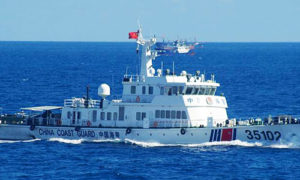Special to WorldTribune.com
 By Donald Kirk
By Donald Kirk
On the chessboard of Northeast, East and Southeast Asia, the players are inexorably arranging their pieces.
A naval exercise, a warplane flyover, a flotilla of fishing boats, a missile launch ― all such gestures, bloodless today, evoke the image of great powers maneuvering for bloody moves tomorrow. It’s as though we’re in a “phony war,” not enough to send civilians scurrying for cover or for armies to go on full alert but worrisome nonetheless.
The tensions build slowly. It’s possible for most of us to ignore them. What does it mean, exactly, if Chinese warships prowl the South China Sea, from the Spratly Islands in the south to the Scarborough Shoal off the Philippines to the Paracels, claimed by Vietnam?

How concerned should we be if the U.S. sends a destroyer within striking distance of any of these morsels of land and rocks or if Chinese and U.S. warplanes dart through the skies?
It may be dangerous to exaggerate the significance of each individual display of force, but two factors seem to be driving the region to the edge of conflict.
First, China is obviously restoring close ties to North Korea. As the U.S. prepares to send the super-counter-missile batteries known as Terminal High Altitude Area Defense (THAAD) to South Korea, the Chinese are not likely to enforce U.N.-imposed sanctions on the North. It’s even possible they won’t object if North Korean leader Kim Jong-Un orders a fifth nuclear test, and they don’t mind at all if he persists in firing mid-range missiles of the sort that might carry warheads to just about anywhere in Northeast Asia.
That’s assuming, of course, that Kim does not order potshots toward China, much though the North Koreans hate to be under the thumb of the Chinese. That’s out of the question considering that China supplies North Korea with virtually all its oil and half its food.
As far as the Chinese are concerned, he can lob those missiles in the direction of Japan, as he did the other day, all he wants. The legacy of the Pacific War ― and Japan’s harsh occupation of much of China ― burns that deeply, or at least such is the justification for Beijing’s inflammatory rhetoric directed at Tokyo.
The second factor that’s raising tensions is Chinese resentment over the ruling by the International Court at The Hague that China has no business asserting domination over the South China Sea. That means the Chinese should get out of the reefs and atolls belonging to others and stop molesting Philippine fishing boats around the Scarborough Shoal, which is a lot closer to the Philippines than it is to China.
The Hague ruling poses a direct challenge to Beijing. The response has to be not only to reject it but to reinforce China’s claim by ever more patrols, dredging around its de facto holdings and blocking alien fishing boats and other intruding vessels.
How long can the Chinese maintain this show of defiance? Probably forever ― or until suffering a loss in war.
But what could drive tensions to the point of opening fire? The appearance in the East China Sea this week of more than 200 Chinese fishing boats around the Senkaku Islands ― or Diaoyiu to the Chinese ― held by Japan but claimed by China, showed the risks.
Half a dozen Chinese Coast Guard vessels faced off against as many from the Japanese Coast Guard. These are not navy warships. Their weapons are water cannons and mega-loudspeakers, but this is a dangerous game risking escalation that sooner or later may erupt in real shooting.
The Japanese are if anything as edgy as the Chinese. Prime Minister Shinzo Abe is slowly doing away with the constraints of Article 9 of Japan’s post-war “peace constitution” banning Japanese forces from going to war on foreign turf. Japan is not about to send warplanes on the attack against the sites from which North Korea is firing its missiles, but what if Kim Jong-Un orders a shot that hits somewhere in Japan?
Like China, Japan is making its moves in a match in which the Japanese may eventually decide they’ve had enough of North Korean missile tests that send projectiles into their waters. As of now they’re preparing counter-missile defenses.
The idea is to be able to shoot down a North Korean missile ― a difficult moving target. Would it not be a lot easier, Japanese commanders and leaders might ask, to respond by firing their own missiles at targets in North Korea?
In the game for power in East Asia, the U.S. exercises a restraining influence. Japan remains a U.S. ally and isn’t yet ready to open a war that would endanger the alliance. The U.S. military presence in Japan ― 50,000 troops, including a large marine expeditionary force on Okinawa ― also provides security for South Korea against Japanese adventurism. Nobody can be sure what a remilitarized Japan, freed from the shackles of alliance with the U.S., would do.
As the players maneuver on the chessboard, the question is how long before an explosion plunges the region into a war that no one wants. No telling what the answer is, of course, but every move drives all sides closer to the point of no return.
Donald Kirk has been covering war and peace in Asia for decades. He’s at [email protected].
